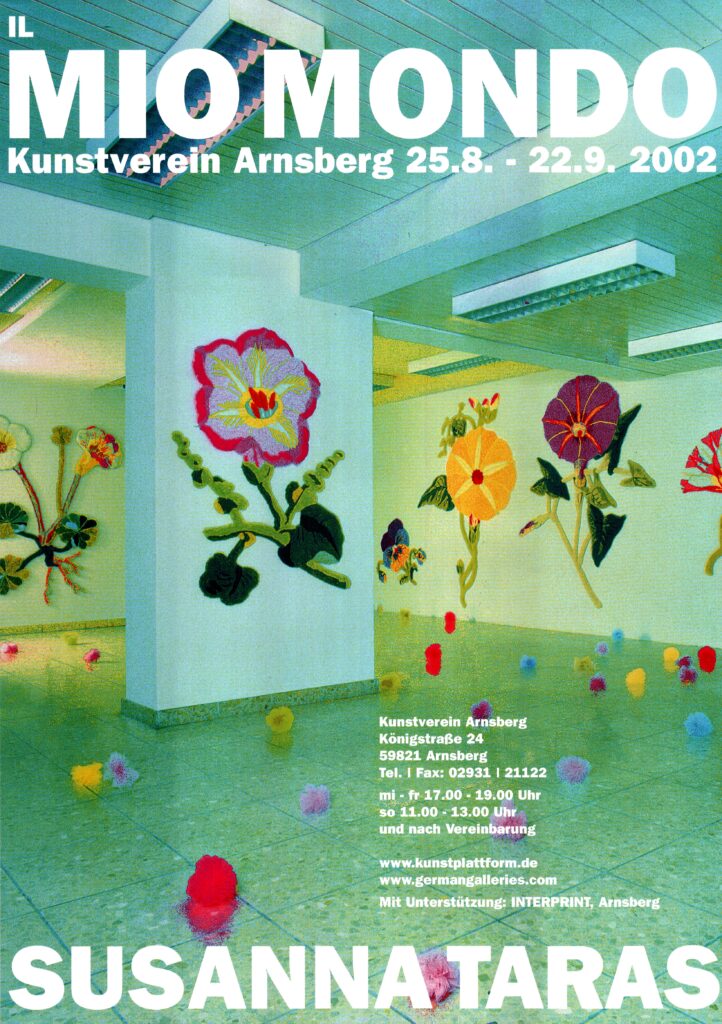Susanna Taras
Il Mio Mondo
25. August – 22. September 2002

Susanna Taras whisks us away into an extremely pleasurable, suggestive and poetic world full of proliferating forms. We are immediately captured by the dynamics of a multitude of color and form impulses. With an almost dancing gaze, we seem to move through the visual density of the spaces. There is a world to discover that appears simple and complex in equal measure, that is sensually extremely concise and yet always surprises us with its ambivalence. There can be little doubt that Tara's pictorial objects represent plants: Flowers in full bloom and leaves in their best green entwine themselves through the rooms. Specific characteristics of individual plant species, such as leaf and flower shapes, even make it possible - assuming a botanical interest - to assign the majority of the plants to a corresponding counterpart in nature. However, this reference to nature is by no means to be understood as a revived mimetic program, as a figurative imitation of nature. The artificiality of the pop-like, striking colors, the playfully enlarged dimensions and the surprising materiality, woven from wool and synthetics, do not even seriously give rise to this suspicion. Tara's flowers are certainly able to remind us of the old and complex relationship between nature and art, between image and visuality, and open up a wide field of semantic meanings. However, the origin of Tara's figurative reminiscences seems to lie primarily in her highly sensitive feeling for the space-creating dynamics of ornamental structures, for their suggestive difference between pattern and ground. In Susanna Taras' work, the flower is less a sign of nature than it appears in paradoxical form as an autonomous fragment of the ornamental principle.
As early as the beginning of the 1990s, Susanna Taras created works that reproduce ornamental structures in brightly colored tapestries. Taras called these works "tapeaux", making it linguistically comprehensible that they are to be placed beyond traditional genre classifications, that they are neither mere "tapis" (carpets) nor simply "tableaux" (pictures). Placed on the floor or hung on the wall, they form an energetically charged force field with their colorful patterns that rise up from the background and enter into a direct relationship with the surrounding space. The floral forms of the current group of works that we see here no longer have any intrinsic pictorial ground. The ground to which they refer as their context lies outside themselves: It is the concrete wall and the equally concrete ceiling. As "shaped canvases", if one may say so, they are thus in a direct relationship to the real space that arises between or beyond them. The bright, energetic colors in which Susanna Taras dyes her wool and synthetic fibers are set against each other in strong contrasts. In their dynamic interplay, the colors add a pulsating, immaterial expansion into space to the factual presence of the pictures. Brightly colored to pastel-colored lines, dots, spots, squiggles and jags communicate with and among each other. Flower shapes, leaves and plant stems are transformed by Susanna Taras into a playground of painterly immanence. The intensity of the color is sometimes forced to such an extent that we gain the impression that it exists independently of the picture support, taking on a life of its own as a luminously vibrating medium in space. This experience is perhaps clearest in the last room, where the color actually seems to have detached itself from the image in order to assert its autonomy in a tense dialogue with image and space. Tara's pictorial concept is dynamic in nature. The viewer moving through the exhibition is presented with her space-filling work in constantly changing variations, sections and distances. Tensions and contrasts can be observed, and not only in the formal sense in relation to the wall and the space. Overall, they concern a paradoxical coincidence of simplicity and ambiguity, of flatness and spatial ambivalence, of figuration, autonomous abstraction and ornamentalization, of micro- and macrostructure, of part and whole.
Beyond all zeitgeisty paradigms, Susanna Taras allows us to participate in a cross-genre play of sensual references, which in its processuality presents itself as unfinishable. By actively participating in this game with our eyes, Susanna Taras' installation actually opens up a world to us.
Jens Papenkort